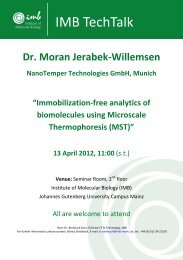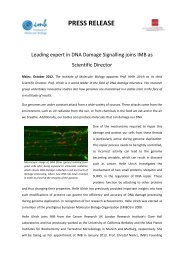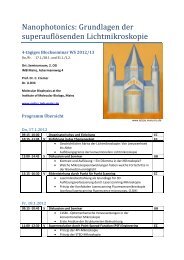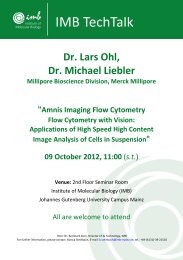Low-resolution PDF - IMB
Low-resolution PDF - IMB
Low-resolution PDF - IMB
Create successful ePaper yourself
Turn your PDF publications into a flip-book with our unique Google optimized e-Paper software.
R o l e o f G a d d 4 5 a n d m e c h a n i s m s o f D N A D e m e t h y l a t i o n<br />
10<br />
“Knock-out mice are<br />
always full of surprises.<br />
Gadd45g mutants led<br />
us to sex determination.”<br />
Christof Niehrs<br />
Education<br />
1985 Diploma in Biochemistry, Free University of Berlin<br />
1990 PhD, EMBL, Heidelberg<br />
1997 Habilitation, Faculty of Biology (Zoology),<br />
University of Heidelberg<br />
Positions held<br />
1990 - 1993 Postdoctoral Fellow,<br />
University of California Los Angeles<br />
Since 1994 Head of Division "Molecular Embryology",<br />
German Cancer Research Center (DKFZ), Heidelberg<br />
2000 Professor of Molecular Embryology, DKFZ, Heidelberg<br />
Since 2010 Professor, Faculty of Biology, University of Mainz<br />
Founding Director, Institute of Molecular Biology (<strong>IMB</strong>),<br />
Mainz<br />
Group Members<br />
Khelifa Arab / Postdoc; since 11/2011<br />
Mathias Gierl / Postdoc; since 07/2011<br />
Wolfram Gruhn / PhD student; since 09/2010<br />
Dandan Han / Research Assistant; since 12/2012<br />
Sabine Karl / Postdoc; since 07/2011<br />
Manuel Leichsenring / PhD student; since 04/2011<br />
Medhavi Mallick / PhD student; since 08/2011<br />
Konstantina Marinoglou / Postdoc; since 09/2011<br />
Bernadette Mekker / PhD student; since 07/2010<br />
Michael Musheev / Postdoc; since 07/2011<br />
Sandra Rölle / Technician; since 04/2011<br />
Andrea Schäfer / Postdoc; since 09/2010<br />
Lars Schomacher / Postdoc; since 07/2011<br />
Dominik Sebastian / PhD student; since 07/2011<br />
Ulrike Stapf / Technician; since 05/2011<br />
Annika von Seggern / Technician; since 06/2011<br />
Research Overview<br />
In the DNA of many multicellular organisms, DNA methylation is<br />
a common epigenetic mark associated with gene silencing. DNA<br />
methylation is dynamic and can be reversed by enzymatic<br />
demethylation, a process which is still incompletely understood.<br />
DNA demethylation is a widespread phenomenon in both plants and<br />
animals that occurs during development, in adults and during the<br />
somatic cell reprogramming of pluripotency genes. We showed that<br />
Growth Arrest and DNA Damage 45a (Gadd45a) is a key player<br />
in active DNA demethylation and acts via DNA repair. The goal of<br />
our research is to analyse the mechanism of DNA demethylation as<br />
well as the role played by Gadd45 in development. We study these<br />
questions by employing the mouse model as a genetic system and by<br />
using molecular biological, biochemical and cell biological approaches.<br />
Research Highlights<br />
Role of Gadd45g in mouse sex determination<br />
Gadd45a,b,g comprise a small family of stress-response proteins<br />
that mediate diverse cellular processes, including DNA repair,<br />
apoptosis, cell cycle arrest, and senescence. They also function in<br />
gene activation by promoting DNA demethylation as well as MAPK<br />
signalling. In DNA demethylation, Gadd45 recruits DNA repair factors<br />
to gene specific loci to initiate demethylation and gene activation. In<br />
MAPK signalling, Gadd45g binds and activates Map3k4 to promote<br />
phosphorylation and activation of the p38 and c-Jun N-terminal<br />
(Jnk) MAP kinases. We aim to understand the mechanism of action<br />
and biological roles of the Gadd45 gene family. In this context we<br />
analysed Gadd45g mutant mice and discovered that the gene plays a<br />
critical role in male embryonic sex determination.<br />
We discovered that Gadd45g mutant mice display complete<br />
male-to-female sex-reversal (Figure 1). Gadd45g and the sex determination<br />
gene Sry have a strikingly similar expression pattern in the<br />
genital ridge, and they are co-expressed in gonadal somatic cells. The<br />
Sry transcription factor is well known to direct the initially bipotential<br />
gonadal anlage towards a male fate and suppresses the female










